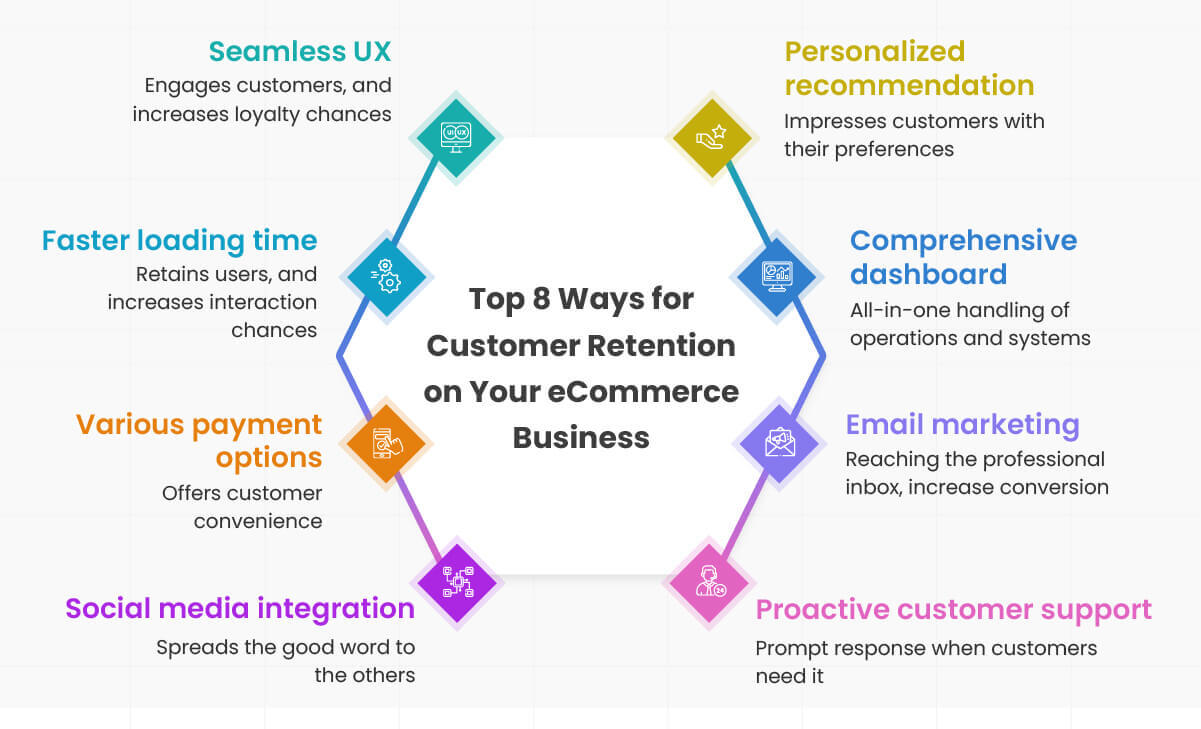When contemplating eCommerce revenue growth, our inclination often leads us to explore tactics aimed at attracting new customers, optimizing the shopping journey, and broadening market reach. While these strategies are undoubtedly vital, they may not be the sole or even the most effective means of retaining your customers. With sales of more than USD 6 trillion, eCommerce holds tremendous potential for your venture.
Your eCommerce business plans begins right from the eCommerce development because you will have to ask your tech partners to include customer-centric facilities and functionalities. Hence, when you opt for eCommerce development, make sure that you include specific features for the convenience and usability of end-users so that they help in customer retention.
In this blog, we will look at eCommerce customer retention strategies to delight your customers and keep growing revenue. You can convey this blog as a customer retention guide to your development team to get the nuances of customer retention art.
What is customer retention in eCommerce?
Customer retention may be defined as the number of people who consistently return to utilize your product or service over time. This indicator shows how well your company can keep customers from switching to rivals, entice them to make more purchases, or just keep using your product regularly, all of which support the long-term growth of your company. After all, you have great potential to tap five billion people on the Internet!
You must be aware of the important event and the period between product consumption to calculate client retention. Right from eCommerce development, you should have effective engagement strategies for customer retention on your website for enterprises. Let’s look at a few of the top ways for customer retention in your ecommerce online business.
Ecommerce Customer Retention on Online Business
Seamless user experience
A continuous flow of a flawless user experience remains the basic principle behind an effective eCommerce, which signifies customer satisfaction and also loyalty. During eCommerce web development programmers need to take care of improving the website speed, ensuring fast page loads as well as the responsive design for a consistent performance on all devices. An intuitive navigation system increases customer satisfaction as the customers can easily search through the products. It is more than just about aesthetics; it captures a deep understanding of human behavior.
The online path through the user-friendly interface from exploration to checkout is very well structured for a pleasant journey. When you create eCommerce store, you not only increase customer satisfaction by investing in a smoothly operating user experience but also build the foundation for lasting relationships that lead to recurring visits and brand loyalty.
Great website speed
However, an essential feature of a successful eCommerce business strategy is the maximizing of website speed as it significantly determines the level of user satisfaction and online performance in general. The loading speed of a website is directly proportional to the user experience, engagement, and also conversion rates. Effective coding and strong hosting in eCommerce web development can speed up the page load times, which creates a very positive impression among the users. This also helps in developing a smooth browsing experience.
If pages load much faster, the users are willing to stay on the site and can continue their browsing for a longer time with higher chances of completing a purchase. Other than user satisfaction, search engines also focus on load times and treat speed as a ranking factor. This highlights the significance of partnering with a good eCommerce website development company to build fast websites not only to improve the user experience but also to increase online visibility and findability levels.

Various payment options
Through the provision of multiple and secure ways to pay, businesses not only increase convenience but also eliminate purchasing boundaries allowing them accessibility to an increased population. Your eCommerce web development can have various payment methods, such as conventional credit and debit cards, digital wallets, or many alternative payment solutions to suit the needs of different customers based on their preferences and uniqueness in the region. This difference encourages an inclusive culture, so allowing their customers to choose the mode of payment that suits their comfort and trust is leading to growing conversion rates as well as improved customer satisfaction.
Social media integration
For an effective eCommerce development, including features that merge social platforms with the process of online shopping, organizations can amplify their brand name recognition and interact more directly with consumers. Social media proves to be a forum for sharing experiences and therefore, the idea of integration as part of building trust among customers should emerge as valuable towards creating a community around a brand.
Secondly, incorporating social proof including customer reviews and testimonials onto the eCommerce website increases its authenticity. This not only gives the potential customers a concrete real-world understanding but also promotes the transparency and authenticity of a brand image. Therefore, integration with social media during eCommerce web development is a very strong channel for customer engagement or brand promotion that helps to maintain steady growth and also retain clients within the competitive online space.
Proactive customer support
With real-time assistance and live chat functionality, eCommerce businesses can proactively prevent any potential complications from intensifying. This relationship not only improves the entire journey of a customer but also creates an image of trustworthiness and reliability for the brand.
Also, the availability of self-service options on the website enables the customers to search for solutions without any assistance thus minimizing friction while addressing their issues. You can enhance your eCommerce development with AI chatbot placement, which assists in faster issue resolution, proactive customer support exceeds immediate issues addressing, and also contributes to an ongoing positive attitude.
Email marketing and campaigns
Email marketing is one of the most important tools for eCommerce, providing a very direct and personalized channel to communicate with customers. Designed in detail, the focused email promotional campaigns work as a very special channel through which highly personalized messages and also product advertisements along with the offered discounts are conveyed to welcoming clients. Email is a very powerful tool for building customer relationships over long periods and also keeping the brand top-of-mind while providing an authentic way to engage in one-to-one communication.
In addition, the use of email campaigns goes far beyond the direct sales. It encompasses creating a story around the brand, providing meaningful content, and creating an interaction going beyond just buying and selling. Through consistent and relevant interactions, eCommerce sites can not only increase sales but also strengthen brand loyalty in an online marketplace that is profiled with many rivals.
Comprehensive customer dashboard
Investing in a customer-centric ecommerce web development strategy involves creating a comprehensive customer dashboard with centralized points based on personal interactions. This intuitive interface empowers users to monitor orders, manage preferences, and utilize personalized recommendations, all while considering ecommerce website development cost.
This centralized repository of information improves the general user feeling as customers can navigate and interact with this platform effortlessly. Secondly, an efficiently designed customer dashboard during eCommerce web development customization transcends beyond the transactional details. It becomes a business intelligence tool that analyzes customer behavior, preferences, and purchase history.
Personalized recommendations and experience
Retention in eCommerce development depends entirely on personalization. Two-thirds of your buyers assume that you must be aware of their unique needs and wants. 52% anticipate that all of your offers will be customized. The age of advanced algorithms and data analytics through which eCommerce platforms direct suggestions that match individual preferences, thus converting browsing into a personally curated shopping experience. This does not only allow for better-informed buying behaviors but it also creates an atmosphere of selectness as well as personalized attention.
However, personalization must reach beyond simply naming the client in your email transmissions. In the case of eCommerce brands, the promotions should be based on the product affinity, prior buying pattern, and also purchase profile.
Conclusion
A key component of every eCommerce business’ success is customer loyalty. Profitability is raised and recommendations and repeat business are encouraged. Ecommerce companies that prioritize retention will succeed in 2024 and beyond. These businesses will focus on retention measures like purchase frequency and net promoter score, foster connections with all consumers, and reward loyalty and referrals. Hence, to build a customer-centric eCommerce web development, contact WeblineIndia, a pioneer in building enterprise-grade websites and web portals.
Testimonials: Hear It Straight From Our Global Clients
Our development processes delivers dynamic solutions to tackle business challenges, optimize costs, and drive digital transformation. Expert-backed solutions enhance client retention and online presence, with proven success stories highlighting real-world problem-solving through innovative applications. Our esteemed Worldwide clients just experienced it.
Awards and Recognitions
While delighted clients are our greatest motivation, industry recognition holds significant value. WeblineIndia has consistently led in technology, with awards and accolades reaffirming our excellence.

OA500 Global Outsourcing Firms 2025, by Outsource Accelerator

Top Software Development Company, by GoodFirms

BEST FINTECH PRODUCT SOLUTION COMPANY - 2022, by GESIA

Awarded as - TOP APP DEVELOPMENT COMPANY IN INDIA of the YEAR 2020, by SoftwareSuggest

